Chapter 5
Using Outlook.com and Microsoft 365
IN THIS CHAPTER
![]() Starting out with Outlook.com
Starting out with Outlook.com
![]() Organizing Outlook.com
Organizing Outlook.com
![]() Finding out if Outlook.com went down
Finding out if Outlook.com went down
![]() Getting to know the Office app, Microsoft 365, and Office Web apps
Getting to know the Office app, Microsoft 365, and Office Web apps
In 2012, Microsoft decided that Hotmail — one of the best-recognized brands on the planet — would be retired, replaced by something completely different. Yes, Microsoft tossed out a brand as well-known as Coca-Cola or the terms taxi or Visa and replaced it with Outlook.com.
If you think that the name Outlook.com was chosen because Microsoft’s new flagship online email-service-formerly-known-as-Hotmail looked or acted like Outlook in Microsoft Office or anything else that’s ever been called Outlook, you’d be wrong. Outlook.com started out as the old Hotmail, with a few internal changes and a new boxy interface. In the years that followed, Microsoft gradually made Outlook.com look and behave more like the other Outlooks — and made the other Outlooks look and behave more like Outlook.com. The match-up is still not perfect, but it’s a lot better than it used to be.
In this chapter, I take you through Outlook.com, with a nod and a wink to Hotmail, which is now officially dead. Then I talk a bit about the Office app from Windows 11, and the “new” Microsoft 365 subscriptions, which are the former Office 365 subscriptions with a new name. Why would Microsoft rebrand Office? I don’t know but someone close to the company’s CEO thought it would be a great idea, and now the Office brand is also being phased out.
Lastly, if you don’t want to pay for Microsoft 365, read the last part of the chapter, where I give you some tips about using Office on the web for free.
Using Outlook.com
When working with Outlook.com, any Microsoft account will do. If you already have an @hotmail.com, @live.com, @outlook.com, or an older @msn.com email address, it’s already a Microsoft account. If you don’t yet have an @hotmail.com or @outlook.com email address, getting one is easy. To create an Outlook.com/Microsoft account, read Book 2, Chapter 5.
Once you have your account ready, log in to Outlook.com (www.outlook.com) and familiarize yourself with the user interface (refer to Figure 5-1):
Default folders on the left are Inbox, Junk Email, Drafts, Sent Items, Scheduled, Deleted Items, Archive, and Notes. You click or tap each folder to open it. Make sure you understand what each one is supposed to contain:
- Inbox gets all your mail as it comes in. If you don’t do anything with it, the message stays in your inbox. The inbox is split into a Focused tab (with emails from people and services you frequently use) and Other (usually with emails from newsletters or people who rarely write to you).
Junk Email holds mail that was sent to you but Outlook.com has identified as being spam. Outlook.com and Gmail have effective junk identifiers, but occasionally a message will get tossed in here that really isn’t junk. If that happens, click or tap the box next to the “good” junk message and, at the top, choose Move To ⇒ Inbox.
You can also drag and drop the message into whatever folder you like.
 If you get a piece of junk mail in your inbox, don’t delete it. You can help the Outlook filters and other Outlook users by marking the message as junk. Just select the box next to the message and, at the top, click or tap Junk.
If you get a piece of junk mail in your inbox, don’t delete it. You can help the Outlook filters and other Outlook users by marking the message as junk. Just select the box next to the message and, at the top, click or tap Junk.- Drafts holds mail you were working on but didn’t send.
- Sent Items contains copies of everything that’s gone out.
- Scheduled contains all emails you’ve scheduled for sending at a later time. Unfortunately, you can do this only from Outlook.com, not from Windows 11’s Mail app.
- Deleted Items is the place where messages go when you delete them.
- Archive is the place where see the messages that you’ve archived instead of deleting.
- Notes is the place where you can create and view notes. They’re automatically synced with the Sticky Notes app from Windows 11 and the OneNote app.
You can create folders. Just click or tap the New Folder link at the bottom of the Folders list.
- The Search box on the top is the most important location on the Outlook.com main page. People go nuts trying to organize their mail. The Search function finds things amazingly quickly. But that’s the topic for the next section.
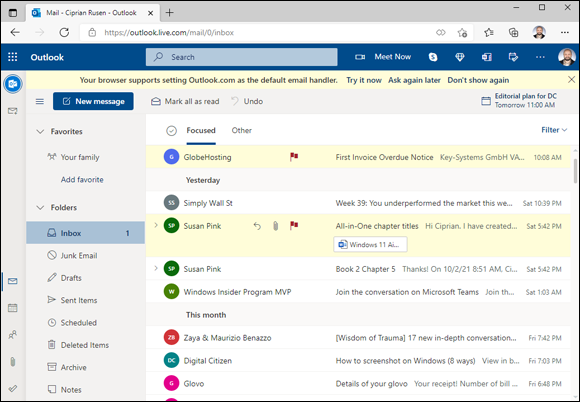
FIGURE 5-1: Your Outlook.com inbox and all its options.
- Outlook.com runs in your browser, doesn’t store any information on your computer, and works only when you’re connected to the internet.
- The Windows 11 Mail app runs on your computer, stores a small subset of your email on your computer, and will continue to work (albeit on a subset of messages) whether or not you’re connected to the internet.
Sweeping emails in Outlook.com
The sweep feature enables you to move all messages sent from a specific email address into a folder. Select one message from the sender you want to move, choose Sweep, and then choose how you want to sweep:
- Move All Messages from the Inbox Folder: Takes the action on all mail sent currently in the inbox from this sender.
- Move All Messages from the Inbox Folder and Any Future Messages: Moves all existing and the future messages from the inbox into the folder you select.
- Always Keep the Latest Message and Move the Rest from the Inbox Folder: Applies to email from only this particular sender. This rule applies to future emails too, not just existing ones.
- Always Move Messages Older Than 10 Days from the Inbox Folder applies to mail from only this particular sender. It does, however, apply to all current and future messages from the sender. Discretion advised.
Here’s how to use the Sweep feature in Outlook.com:
- Open Microsoft Edge and sign in to Outlook.com.
In your inbox, select an email from a sender whose messages you want to sweep, and click or tap Sweep on the top.
The Sweep Messages dialog box appears, as shown in Figure 5-2.
- Select the option you want from the list.
- Click or tap the Move To drop-down list and choose the folder where you want to move the messages from this particular sender. If you want to delete them, select Deleted Items.
Click or tap OK.
All the messages from that sender are moved according to the Sweep rule that you have selected.

FIGURE 5-2: The Sweep options available in Outlook.com.
Bringing some sanity to your Outlook.com inbox
Here’s my number-one tip for Outlook.com users:
If you have an Archive folder, don’t create any new folders.
That way lies madness. Yes, you can create a folder hierarchy that mimics the filing cabinets in the Pentagon. You can fret for an hour over whether an email about your trip to the beach should go in the Trips folder or the Beaches folder — or both. You can slice and dice and organize ’til you’re blue in the face, and all you’ll have in the end is a jumbled mess.
Here’s my number-two tip for Outlook.com users:
If you don’t have an Archive folder, create one — and use it.
If you want to save that message about your trip to the beach or that gorgeous Pinterest mail, just click or tap the message and then click or tap the Archive tab at the top of the Outlook.com window. Or drag the message to the Archive folder. See Figure 5-3.
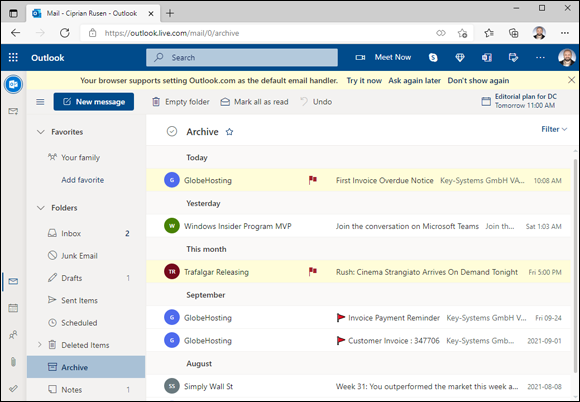
FIGURE 5-3: The Archive folder (note the Archive heading at the top) can hold any mail you don’t want to delete.
The first time you click or tap the Archive button at the top of the Outlook.com window, it offers to set up a new Archive folder for you. After that, anything you archive goes into that folder.
Additionally, people get caught up in categories or flags as a way to organize and sort mail. Outlook.com comes with built-in flags and categories too. If you work well that way, hey, knock yourself out. But note that there’s only one kind of flag; you can’t set up different flag colors as you can in some email programs. My general approach is to blast through email as quickly as I can, responding to what needs responding and deleting or filing the rest immediately. De gustibus non est disputandum.
Handling Outlook.com Failures
Any computer system in general — and online systems in particular — have failures, Outlook.com included. If Outlook.com starts acting up on you, here are two websites you should consult:
- Microsoft’s Service Status site (see Figure 5-4) gives you the latest information about Outlook.com’s current health — from Microsoft’s point of view. Unfortunately, the site has been criticized for being slow to show updates in real time. In the past few years, Microsoft’s network going down has, at times, also taken the status reporting sites down (
https://portal.office.com/servicestatus). - Downrightnow, which isn’t aligned with Microsoft, gives you a crowdsourced consensus view of what’s happening with Outlook.com/Hotmail. Downrightnow (shown in Figure 5-5) not only actively solicits comments from people who visit the site but also has a Twitter monitoring program that finds some of the tweeted complaints in real time (
www.downrightnow.com/hotmail). Yes, the URL is for Hotmail, not Outlook.
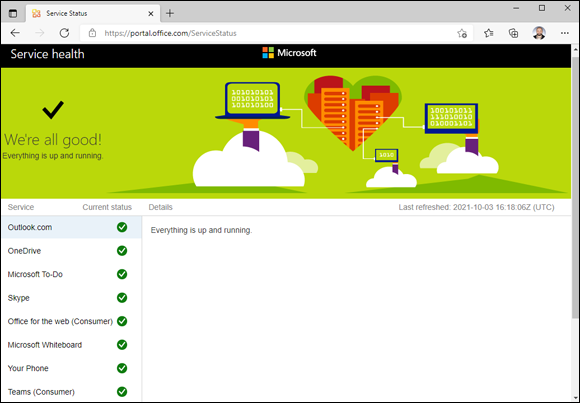
FIGURE 5-4: Microsoft’s Service Status site gives a broad overview of the current status of Outlook.com.
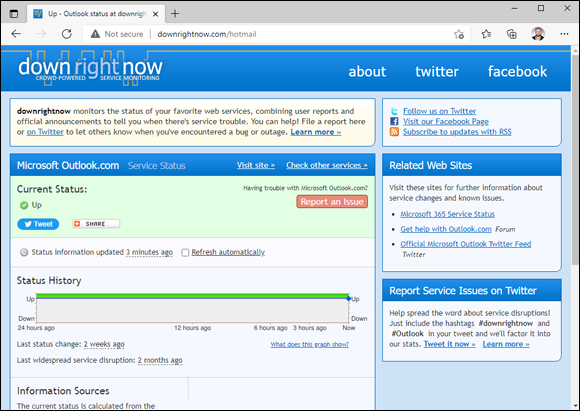
FIGURE 5-5: Compare the Microsoft party line with the crowdsourced Downrightnow.
The Office App and Microsoft 365
When you browse the apps preinstalled with Windows 11, you'll stumble upon the Office app. When you start it, you'll see that it’s mostly a portal to Microsoft 365 (formerly known as Office 365). The app is useful only if you use a Microsoft account connected to a Microsoft 365 subscription.
To the left of the Office app (see Figure 5-6) are shortcuts to the apps that are part of the Microsoft 365 subscriptions: Word, Excel, PowerPoint, Outlook, OneDrive, Teams, and OneNote. A click or tap on their icons, and the apps start right away. In the middle of the Office app are your recently opened files, and at the top area My Account and Install Office buttons.
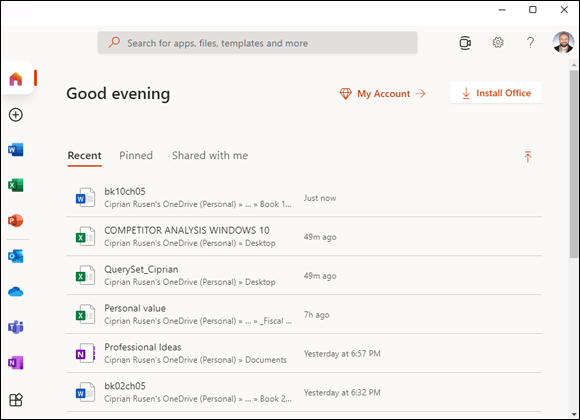
FIGURE 5-6: The Office app promotes Microsoft 365.
Now, when it comes to office apps, Microsoft is the king of the hill, and there’s no debating that its Office suite is extremely useful and chock-full of features. If you want to use Word, Excel, PowerPoint and all the other apps included, Microsoft 365 subscriptions for home users are available in two types of plans: Personal and Family. Personal is for one person and five devices (Windows, Mac, iPhones, and Android devices), and it costs $69.99 per year. Family is for up to six people and five devices for each and costs $99.99 per year. If you want to compare them, visit this page: www.microsoft.com/en-us/microsoft-365/buy/compare-all-microsoft-365-products.
Business subscriptions start with Microsoft 365 Business Basic, which cost $5 per user per month, up to Microsoft 365 Business Premium for $20 per user per month. Their features vary and get more complex as the cost per user increases.
Home users can still buy the traditional Office package, Office Home & Student 2021, for a one-time fee of $149.99. However, it's tied to a specific PC, not to a Microsoft account. If you change devices often, the Microsoft 365 subscription is the best choice because the traditional Office package won’t migrate with you to a new device.
Using the Free Office Web Apps
If you don’t want to pay for Microsoft Office or purchase a Microsoft 365 subscription, you can use the free apps offered by Microsoft. In Microsoft Edge or your favorite web browser, navigate to www.office.com and sign in with your Microsoft account. You’ll open a portal that’s identical to the Office app in Windows 11 (see Figure 5-7). The shortcuts and the entire layout are the same. However, when you click or tap the Word, Excel icons in the column on the left, the free Office web apps open instead of their desktop counterparts.
Office web apps offer slightly fewer features, but they work well and are remarkably similar to the mobile Office apps on Android devices, iPhones, and iPads.
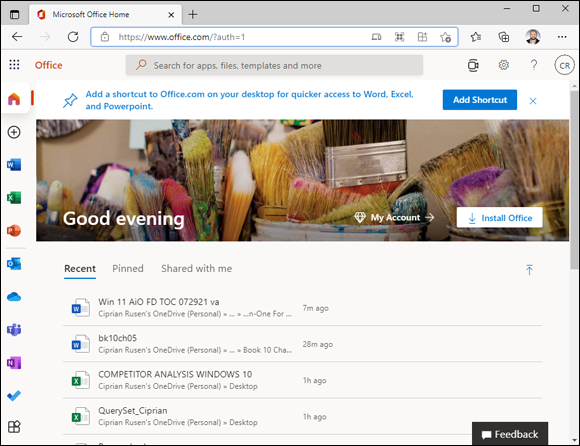
FIGURE 5-7: Office.com is the same as the Office app in Windows 11.

 If you want to find all the messages about trips, use the Search box. If you want to find all the messages about beaches, use the Search box. And if you want to find all the messages about trips and beaches … wait for it … use the Search box!
If you want to find all the messages about trips, use the Search box. If you want to find all the messages about beaches, use the Search box. And if you want to find all the messages about trips and beaches … wait for it … use the Search box!